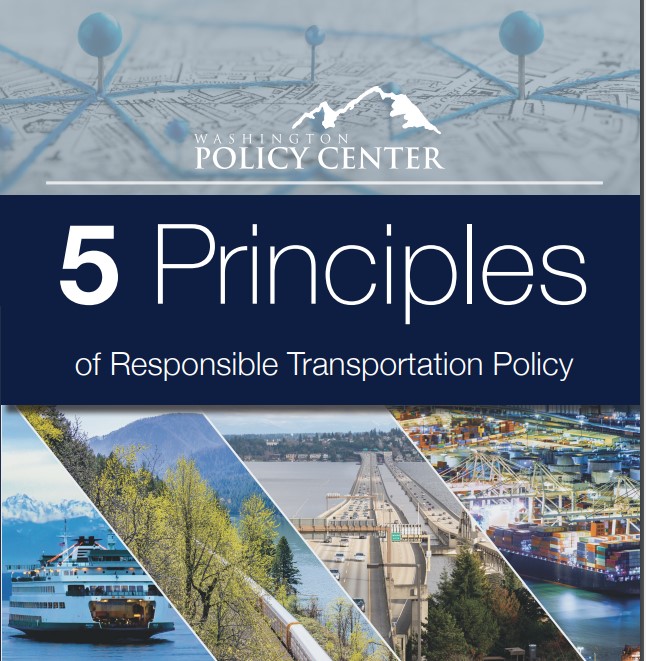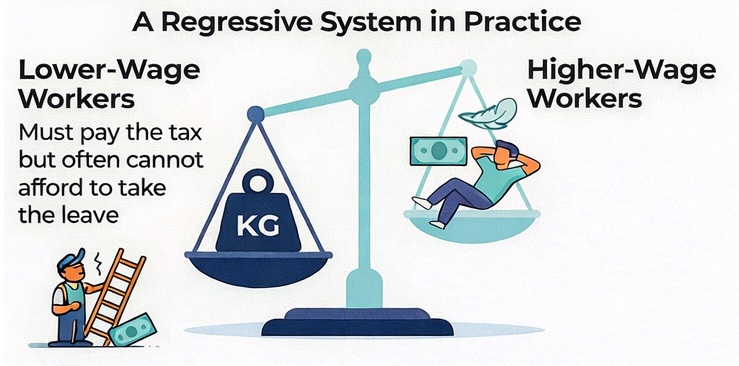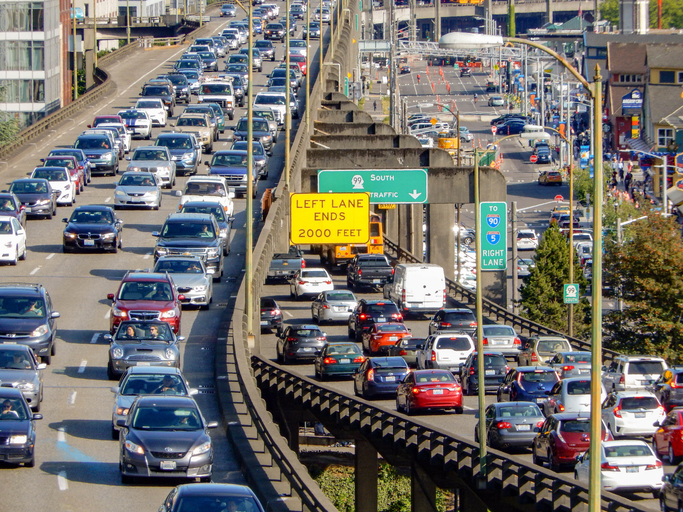Key Principles
- Make reduction of traffic congestion a top priority and tie state transportation funding to achievement of efficiency performance measures.
- Respect freedom of mobility by directing resources to the projects that are most cost-effective in accommodating travel demand.
- Improve freight mobility
- Create a supportive regulatory environment for new transportation technology.
- Strengthen the users-pay/users-benefit principle by requiring that all revenue and tolls collected from highway users are dedicated to highway purposes.
Read and download the full publication here!
1. Make reduction of traffic congestion a top priority and tie state transportation funding to achievement of efficiency performance measures.
Achieving smooth flowing traffic is an important goal of any transportation public policy, yet it is not a priority in Washington state.
Mobility should mean traffic relief, but state officials define it in terms of increasing public transit ridership. This is used to justify shifting resources from reducing congestion to providing slow, costly, and far less popular alternatives. Statewide, automobiles are the primary mode of access to work, with about 80 percent of work trips in the Puget Sound region fulfilled by car. Transit trips are overwhelmingly concentrated in Seattle. In the Puget Sound region, transit, walking, biking and working from home make up only about 20 percent of trips. Focusing limited transportation dollars on that 20 percent while letting the remaining 80 percent languish will lead to greater congestion, reduced overall mobility, and limited job opportunities.
In 2007, lawmakers replaced specific performance benchmarks for transportation funding with six vague policy goals, severing the tie between congestion relief and transportation spending. Replacement of those goals and the elimination of the goal of congestion relief altogether is still sought by some lawmakers and officials. They advocate for unmeasurable goals including health, equity and environmental justice. Washington policymakers should return to prioritizing congestion relief and performance measures for reducing travel delays and maximizing the number of jobs that can be reached by citizens within 30 minutes.
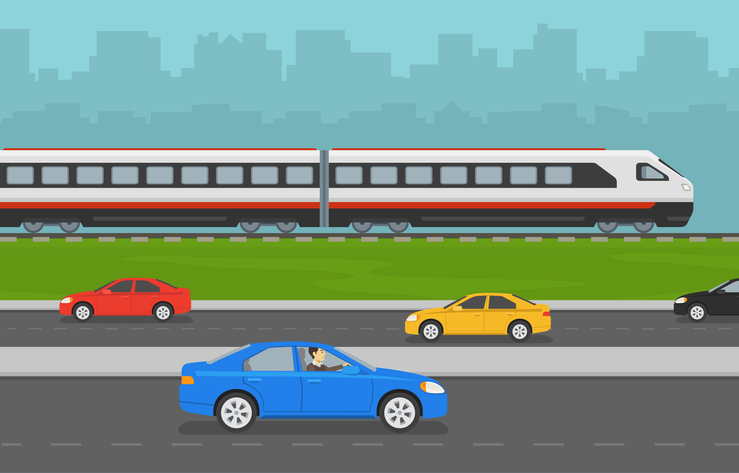
2. Respect freedom of mobility by directing resources to the projects that are most cost-effective in accommodating travel demand.
Government policies in transportation should improve the freedom of citizens to live and work where they choose.
Transportation policymakers should use consumer demand to guide and prioritize spending. Policies that create greater dependency on subsidized transportation and housing and coerce people to abandon how they prefer to live or travel are inappropriate for a state transportation agency to advocate. Policymakers too often insist that increasing the supply of transit will somehow induce public demand. This speculative model has failed because most U.S. cities do not possess the economic or demographic characteristics that create enough voluntary consumers for public transit.
Building excess transit capacity before there is an equal amount of willingness to use it guarantees an underperforming system. Nowhere is this more apparent than in the Puget Sound region, where Sound Transit officials are spending billions of dollars on a light rail system. Yet light rail is forecast to carry less than 5 percent of daily person trips in the region by 2050. Still other policymakers work to expand policies like urban growth boundaries and zoning single-family residential neighborhoods for multi-family construction in order to increase population density, drive people into alternate modes of travel, and “manage” travel behavior.
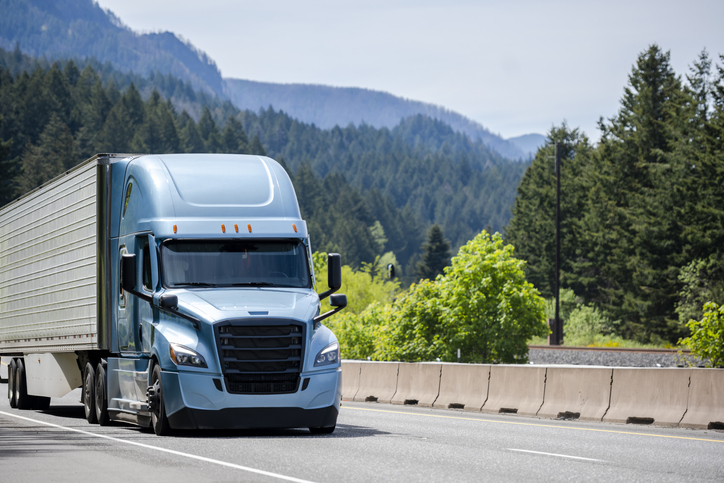
3. Improve freight mobility.
Freight mobility is key to our state’s economic strength.
Every item in every store has been moved in a truck, twice or even more times. Washington State’s prosperity depends on trade at home and abroad. Highways, which carry 70 percent of all commercial truck freight, are already congested, and that congestion is expected to double in the next 20 years. According to data from the American Trucking Association, congestion results in 1.2 billion hours annually of lost productivity in the trucking industry -- the equivalent of about 425,533 commercial trucks sitting idle for one year. The added costs from the lost time and surplus fuel burned amount to $74.1 billion annually.
Despite billions of unmet transportation infrastructure needs, local and state leaders spend our transportation tax dollars in areas that reduce freight mobility. Replacing the Seattle Viaduct with two fewer lanes, replacing the Highway 520 Bridge with no additional general purpose lanes, replacing the center lanes on the I-90 bridge with light rail, and ignoring the I-5 bottleneck through Seattle have all made transportation more difficult. The number of general purpose highway lanes connecting the state to its largest employment hub will decrease in the next 20 years, despite regional population increases of more than one million new residents. Responsible transportation policy must recognize freight mobility is critical to Washington’s economic health and fund projects that improve it.

4. Create a supportive regulatory environment for new transportation technology.
Vehicle automation technology will create opportunities and necessitate changes in state laws
In 2017, Governor Jay Inslee issued Executive Order 17- 02, which established the state’s Autonomous Vehicle Work Group to advance the objective of “enabling safe testing and operation of autonomous vehicles on public roadways,” the benefits of which include the reduction of collisions caused by human error, improving mobility for those who are elderly or disabled, and “maximizing our ability to move people and goods quickly and safely throughout the state.” Members of the AV Work Group are working to finalize a policy framework for “cooperative automated transportation” in Washington state. While this is a meaningful exercise, many of the policy goals are either unnecessary or too prescriptive.
To facilitate the safe testing and deployment of automated transportation in our state, laws and regulatory systems should not impose restrictions that narrow the scope of development or unnecessarily delay adoption, thereby increasing costs to the public. Reasonable steps to maintain public safety are warranted. The State’s vision for transportation should be neutral with regard to mode, focused on improving personal mobility, enhance public safety, and recognize the importance of privately operated vehicles in enabling mobility and commerce.

5. Strengthen the users-pays/users-benefit principle by requiring that all revenue and tolls collected from highway users are dedicated to highway purposes.
The 18th amendment to the State Constitution requires that fuel taxes and tolls collected by the state be used for highway purposes
The motor fuel tax first adopted by states in the early 1900s to fund the construction of highways and roads was born of the principle that users should pay for the impact of their use. Many states protect fuel tax revenue through statute or state constitutional provisions, ensuring money cannot be used for non-highway expenses. When lawmakers are able to divert gas tax revenue to pay for non-highway programs, it politicizes and violates the users-pay principle, leaving less money for roads.
The National Academy of Sciences (NAS) has found that overall, “most of the [Interstates] have exceeded their design lives and in many places are worn and overused.” The Road Information Program (TRIP) found 27 percent of Interstate bridges need repair or replacement, while 54 percent are at least 50 years old, and 47 percent of Interstate miles are severely congested during peak travel periods. Policymakers must recognize the importance of safe and reliable highways that promote mobility and access to employment. Strengthening the users-pay principle will ensure that motor fuel tax revenue is directed to road safety and dependability improvements.
In the long-term, as technology advances and vehicles use different methods of propulsion, officials may seek to replace the gas tax with a per-mile charge related to the cost of road maintenance and repair. Policymakers should ensure that any gas tax replacement is protected solely for road spending.
Download the full publication here!

